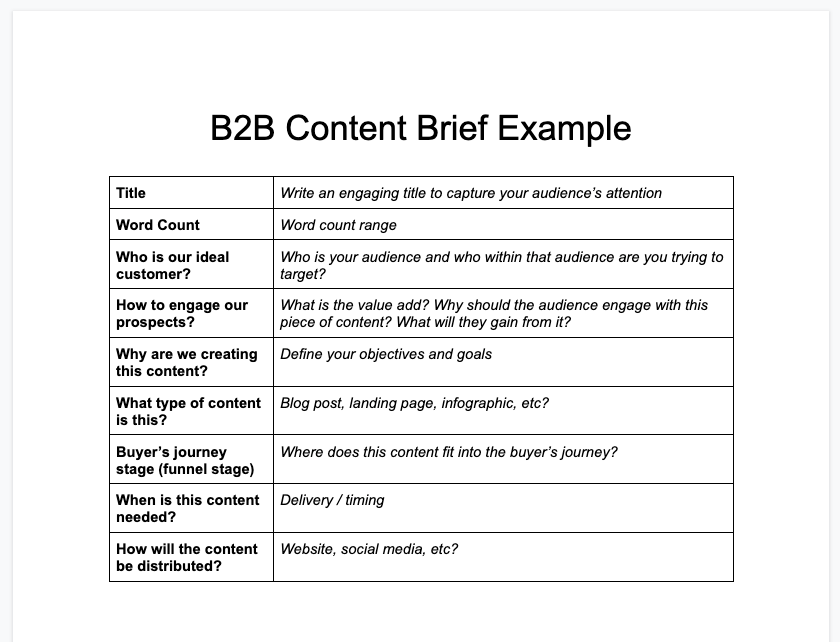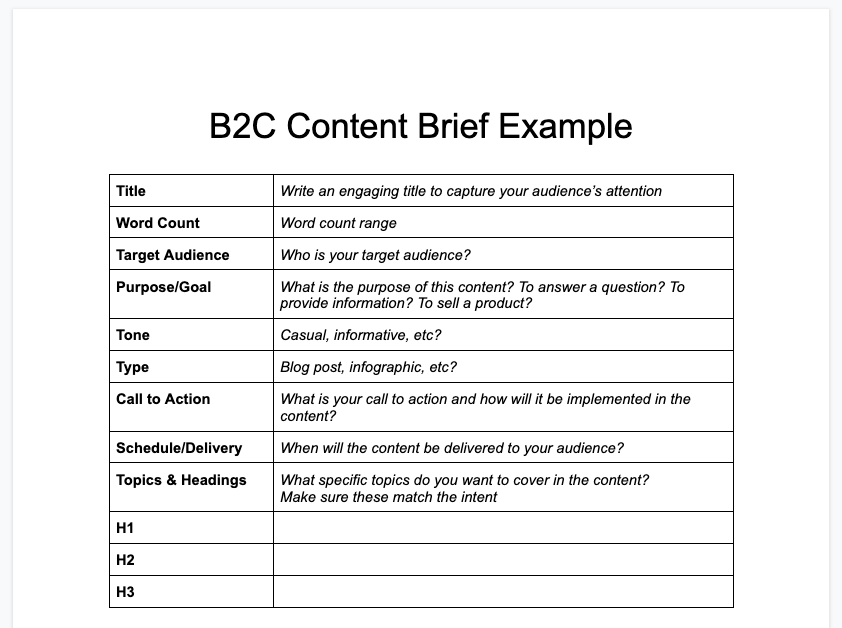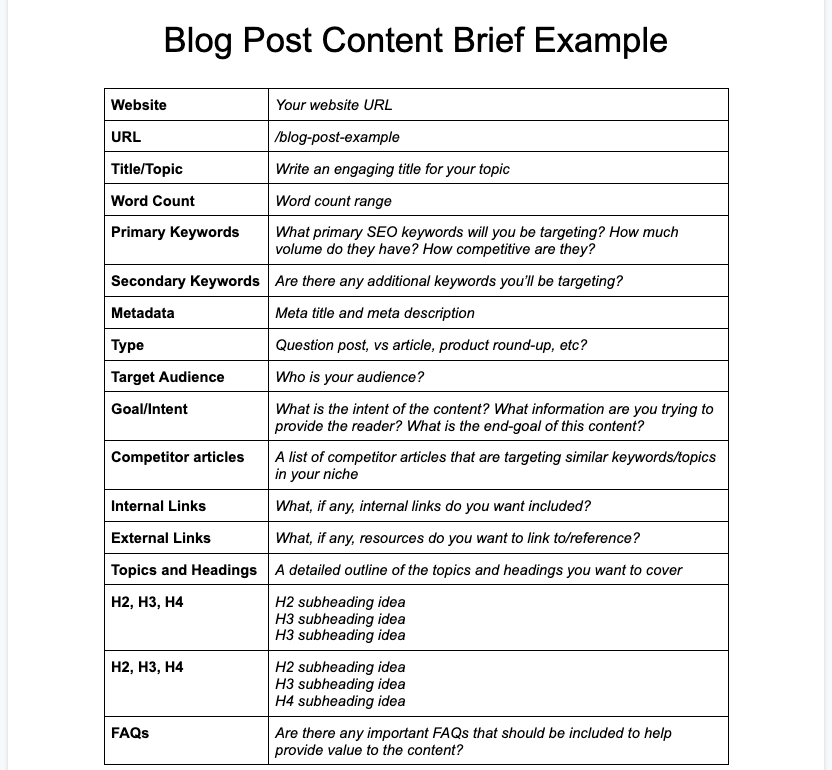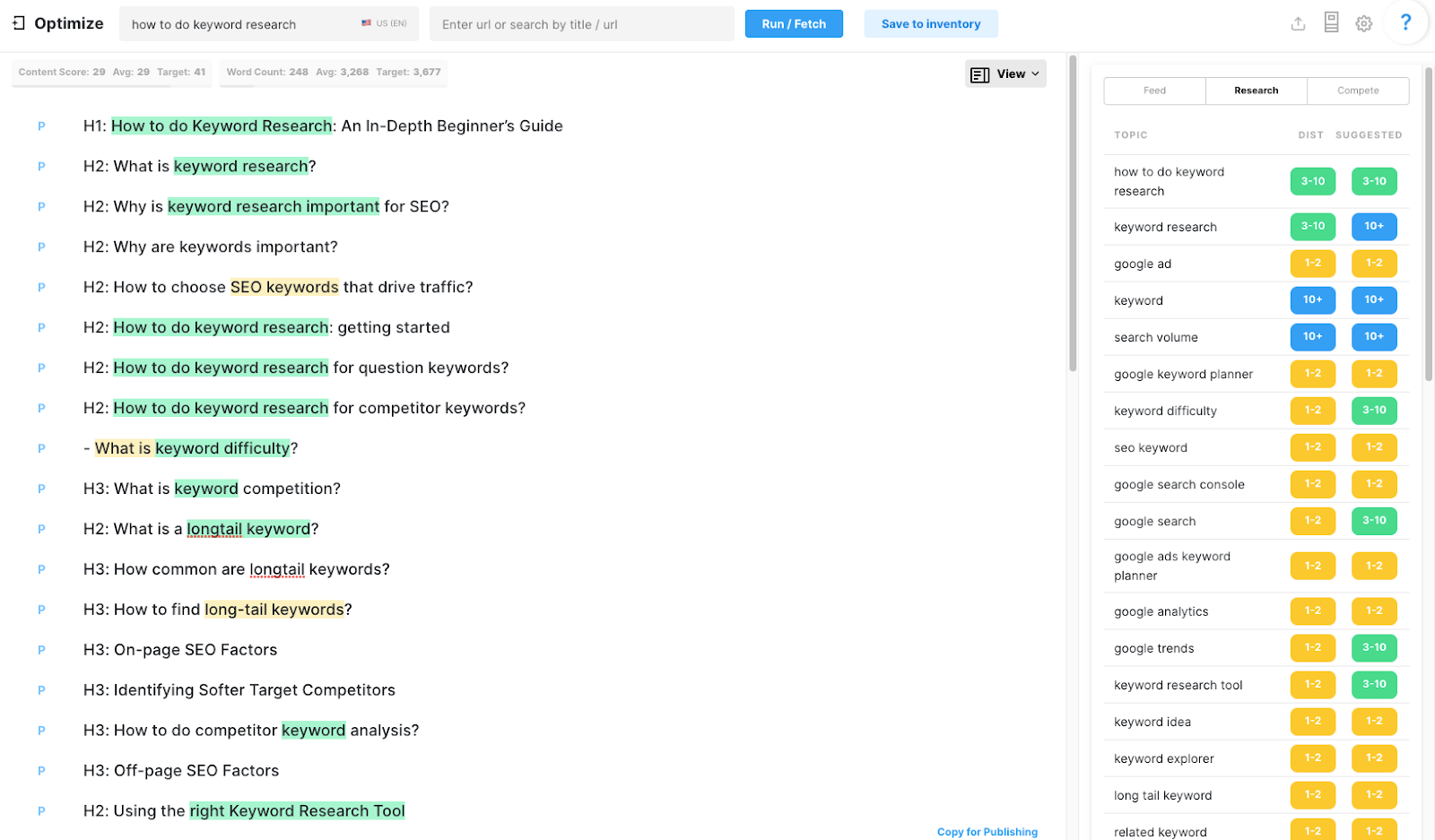If you own a website, are a content creator or a freelance writer, then you’ve most likely heard of a content brief. While much of the SEO world focuses on keyword research, content curation, website optimization and a dozen other factors, content briefs are an important part of the content creation process.
If you own a blog or affiliate website, then understanding what content briefs are and how to create them is critical to writing content that will stand out. In this article, we’re going to dive deep into everything you need to know about content briefs.
What Is a Content Brief?
A content brief is a detailed outline of what a piece of content will include, its target audience and its intent. It contains the guidelines, requirements and important information that will guide the writer in creating the content.
Some content briefs can be more detailed than others — this really depends on who will be writing it and what the content’s purpose is. However, there are six key elements that need to be included:
- Intent: What is the purpose of the content and what are you trying to achieve and/or answer with it?
- Angle/Tone: What direction do you want to take the content in and what tone of voice will you be using?
- Intended Audience: Who are you trying to target?
- Goal: What is the content aiming to achieve?
- Keywords: What keywords, phrases and search terms are you trying to target with the content?
- Funnel Stage: At what point in the funnel is this content being written?
Depending on what you’re using the content for, these elements can vary and some may be more important than others.
For example, a B2B business may focus a lot more on what funnel stage they’re releasing their content, whereas a news site will focus more on their audience — it might not even worry about funnel stages or keywords.
Regardless of your process, content briefs provide instructions and structure to each piece of content in order to help curate it for the right target audience.
Why Are Content Briefs Important?
Any piece of quality content can go in a variety of different directions. With a structured outline, this can be laid out section-by-section and flow naturally. However, without structure, the content can jump from one topic to another, have no flow and confuse the reader.
To understand why content briefs are important, let’s quickly go over each of the key elements in more detail and why they’re crucial to creating quality content.
Intent
This is arguably the most important element of any piece of content. If you don’t understand what the article’s intent is, then it serves almost no purpose. Many times, intent can be obvious. For instance, the intent of a breaking news article is to deliver time-sensitive information quickly and succinctly to an audience.
However, other times, intent can be more broad. For instance, an article on a beginners guide to skiing can have a number of topics to cover — how to ski, where to ski, what skis to use, the list goes on and on. So, before writing an article like this you have to narrow down what the intent of it will be.
What are readers looking to get out of the article? What questions do they want answered? Once you understand these things, then you can cater your article to the intent of the target audience.
Angle and Tone
Understanding who your readers are and how they want the content written can help you to capture their voice and attention better. Is the content aimed at a more casual reader or someone who understands the topic well, but is looking for a more advanced analysis? Tone can also include branding guidelines or other relevant requirements to match the target audience.
What is your angle with the content? Are you providing information, selling a product or reviewing a list of items? Regardless, making sure your content sticks to that angle throughout the entire piece will ensure the reader gets the most value.
Audience
This one’s simple, but highly important. Understanding who your target audience is can be the difference between someone reading an entire article or skimming the first few sentences and moving on.
Make sure you understand who you’re targeting and that the content is curated for them — i.e. tone of voice, length of paragraphs, images, etc.
Goal
What is the goal of content? What are you trying to achieve? Don’t overthink this one — if you’re just trying to provide some information to your readers, that’s fine! Or if you’re trying to sell a product, then your goal is “sell [xyz] product”.
The goal can be simple, but make sure that your content sticks to that goal throughout the entire process. Don’t try to do too much at once with a piece of content. And make sure you actually hit your goal.
For instance, if your goal is to provide valuable information about a search query, then make sure it is, in fact, valuable.
Keywords
Understanding what keywords you’re targeting can be critical to your content ranking. Are you targeting keywords with enough search volume? How competitive are the keywords you’re targeting? Does the intent of the keyword(s) match the intent of your article?
Keyword research can be an entirely different beast to conquer. If you’re new to this world and need help understanding how to do keyword research, you can read more on what keywords are here.
Funnel Stage
The importance of this stage can vary depending on what you’re writing your content about. If you’re a business owner, then understanding what stage your readers are in when consuming the content is critical as it will change the overall tone, intent and information included in the content.
However, for many site owners and/or content creators, this may be less important. For instance, if you’re answering a simple question, then your focus will be more on the intent and value your content is providing rather than what stage of the funnel they’re in.
When Do You Need to Create a Content Brief?
Creating a content brief is always important. However, if you aren’t sure if or when you should create them, here’s a quick list to help you decide.
You should create content briefs if any of the following apply to you:
- You or your content team produce a lot of written online content on a consistent basis
- You work with a team of writers or editors (i.e. manage an editorial team)
- You hire new writers or work directly with a content agency/partner
- Your content goes through an editing process
- Your content production runs into bottlenecks
- Your content production deals with time constraints
- Your content has issues with consistency in quality
- You have or want to create a content marketing strategy
Content Brief Examples
What’s included in a content brief can vary greatly depending on a number of factors. Before creating content briefs for content on your site, first, you need to create a template based on your needs.
Below are some examples of different content briefs that apply to different businesses and websites. You should use the ones that apply most to you and tweak them if needed.
B2B Content Brief Example

Here’s a simple example of what a B2B content brief would look like — depending on your focus, you may want to include more details.
These are all the same elements we outlined at the start of this article, but catering to a different niche. This content brief puts more emphasis on the audience or “buyer” and how the content will be delivered. There’s not a major focus on keywords or SEO because that’s not the main goal of this content.
B2C Content Brief Example

With a B2C content brief, the main focus will be on the audience — everything should be centered on them. You need to ensure that the topic you’re covering is relevant to your target audience and provides them with the correct information they’re looking for.
It’s important to outline the topics and headings the content will cover because a) it ensures that you’re covering all the relevant information that pertains to the overall topic and b) it ensures that the content flows naturally from subject to subject.
Blog Post Content Brief Example

Depending on what your website is focused on, what niche you’re in or who your audience is, a blog post content brief can vary. While this is a general outline that will help you get started, you may want to add to it based on your needs and goals.
Typically, with a blog post, your main goal is to gain organic traffic from it. That means you’ll need to place an emphasis on targeting the right keyword, audience, and providing value to the reader. The content brief should include all these things in as much detail as needed for the writer. You’ll most likely want to outline the specifics of the article in the content brief — this means including the exact topics and headings in the appropriate order.
SEO-Optimized Content Brief Example

If you have access to content optimization tools, such as Marketmuse or SurferSEO, then using these can be a great way to create content briefs. These tools will provide you with key phrases to help content rank, while also helping to map out your content.
Although SEO tools are great for mapping out content, you’ll still need to add in the other key elements, such as word count, metadata, intent, etc.
What Should a Content Brief Include?
We’ve gone over the key elements of a content brief as well as some great examples of how a content brief can look. Next, let’s go over everything that a content brief should include.
As you go through each item below, be sure to assess whether or not your content brief needs to include it — depending on the intent of your content, some of the criteria below may be more important than others. For example, a publisher focused on SEO may want to include specific subheadings focused on optimizing the content, whereas a B2B business may focus more on the tone and branding guidelines.
Here is a list of criteria to consider when creating your content brief:
- Suggested title and headings
- For most, including an exact title makes it a lot easier for the writer and publisher — this eliminates any further revisions
- Including subheadings is important and helps you and the writer map out the structure and flow of the content
- Recommended word count
- This tells the writer how in-depth the information provided needs to be
- Deadlines and/or milestones
- This gives the writer a deadline and also helps you schedule your content
- Primary keywords
- Identify keywords to give the writer a focus on what the article’s intent will be
- Secondary keywords and/or long-tail keywords
- These allow the writer to understand which sub-topics need to be covered
- Questions the content should answer (FAQs)
- This allows the writer to understand what relevant questions need to be answered throughout the article
- FAQs also provide more value to the reader
- Goals for the content
- What are you trying to achieve with the content?
- Search intent/Content intent
- This allows the writer to match the intent of the topic you’re covering
- It also makes the content more valuable to the reader — if you’re matching search intent, then you’re answering search queries
- Metadata
- Including metadata (such as a meta description) will help with the publishing process and should always be included for SEO content
- Details about target audience
- Providing an overview of who the target audience is will allow the content’s tone to line up more with the reader
- Branding guidelines
- If you have specific wording, phrases or a tone that need to be followed, including a branding guideline is important
- Style, format and tone
- All of these will determine how the content is written
- If all of your content follows similar formatting guidelines, then creating a separate content brief for this would be useful — that way you don’t have to rewrite them each time you create a new brief
- Outline of the content and sections
- An outline allows you to map out the content exactly how you want it
- It also makes the writer’s job much easier, reducing the need for future revisions
- Requirements for internal links and external links
- Internal and external linking will help your overall domain authority
- External links can be important if you’re linking to specific products or affiliates
- Background research and/or resources
- Depending on how specific or detailed your content will be, providing links to background research can help the writer determine exactly what needs to be covered or referenced throughout the content
- Calls to action (CTAs)
- Guidance on visual elements (images, graphics)
- Images or infographics can be very useful for content — they help break up the content and can provide useful visual cues for the reader
How to Create a Content Brief
Creating and planning your content using content briefs can make your life much easier.
By having a schedule that your content team can follow, content production will become seamless and take a lot off your plate. Let’s go through a step-by-step guide on how you can create your first set of content briefs.
1. Select Your Topics and Angle
You have the ability to tell your story in many ways.
To produce the best content, it’s important that you think about the editorial direction for this piece before writing a content brief. There are a number of ways to go about this, which we’ve detailed below:
Analyze Your Competitors
This is one of the best ways to develop a content plan for your site. What is your competition writing about? What topics are they covering? What are they NOT covering?
By looking at the top ranking articles, you’ll be able to find popular topics and opportunities in your niche. Find ways to differentiate yourself from them while staying within your niche.
Do Keyword Research
Keyword research often lights a path forward when it comes to topics. You may think you know what readers want, but keyword research will give you a better understanding of what they’re searching for.
Consider subscribing to Ahrefs or SEMrush to get the most out of your keyword research. These tools will help you find your primary keywords, seed keywords and long-tail keywords, and then lay them out in a content strategy. Plan out your topics based on your niche and how relevant it is to your target audience.
This process can have such a profound impact on the content planning phases that we’ve explored the process in greater detail in the next section.
Scope Out Social Media
Find popular topics and categories in your industry by scanning Reddit, LinkedIn, Twitter, etc. What are people asking? What are the popular topics gaining traction? Readers tend to go to social media for many of their questions and you’d be surprised how much information you can pull from here.
Get It Directly From the Source
If you’re able to, talk to your customers. Ask what they’re looking for or what they’re interested in knowing. A quick customer survey will give you a much better understanding of their needs.
2. Dig Into Keyword Research
Whether you prefer to brainstorm ideas first, check out social media or survey your customers, it’s essential that keyword research is also an integral part of your early stage content planning.
Keyword research not only gives you a better understanding of the market, but it also provides valuable insights that can help improve your writing.
When using either of the tools previously mentioned — Ahrefs or SEMrush — there are two key analytics to consider:
- Search volume: This gives you an approximation of how much organic search traffic is going to a primary keyword (i.e. how many times someone is searching for this phrase in Google). The higher the search volume, the more potential traffic available.
- Keyword difficulty: This indicates how competitive a primary keyword is. How many other sites are ranking for it? How many articles exist online that are covering this topic? The more competitive a keyword is, the harder it will be to rank for.
In order to produce content that makes readers happy and ranks well on search engines, you need to use a two-step keyword process.
Target Keywords
When selecting keywords, the most important thing to consider is whether they align with your angle and niche. Do they fit with the target audience you’re trying to reach?
For example, let’s say you have a website selling golf products and equipment. You may want to categorize your content plan by each product you sell — clubs, golf balls, range finders, tees, simulators, etc. Any of these would be a good target keyword.
These would be your primary keywords. From there, you’ll want to narrow it down even further into seed keywords. For example, golf clubs could be narrowed down into drivers, irons and putters. From there, you can narrow it down even further — 7 irons, 8 irons, etc.
Be as specific as you can, then use keyword research tools to identify what primary keyword and seed keywords or phrases you want to focus on.
Keyword Intent and Long Tail Keywords
You’ll also want to categorize the types of keywords you’re searching for. Are you writing content for a product page? If so, then targeting keywords around those products — i.e. drivers or irons — makes sense.
But let’s say you also want to create informational blog posts on your site to help drive more traffic. In that case, you’ll need to get more specific with your keyword research.
For example, the keyword “7 iron golf club” might be a good keyword to target for a product page. Using Ahrefs, we can see that people searching this keyword are most likely looking to purchase a 7 iron.

However, a good supporting keyword for this category might be “how to hit a 7 iron”. This would be a great keyword to target for an informational blog post, then link back to your product pages for 7 irons using a CTA.

These are long tail keywords and can be great to use for writing content and generating briefs. You can use primary keywords to help identify what these are or use Google’s “people also ask” section.
Looking at the “people also ask” section within your niche can provide you with some invaluable insight.
Regardless of how you find them, always make sure that the intent matches your website’s goals. Do you want people searching for “how to hit a 7 iron” coming to your site? Is that traffic going to be valuable to you?
3. Organize Your Topics and Keywords
A content brief ensures that the writer understands your goals for the piece and produces content that is aligned with your website or company’s branding. A writer will do their own research to produce original, engaging content, but it is important for you to help guide them so that each new piece fits in with the rest of your site’s intent.
Make sure that you include all the relevant information for your content team and schedule the content ahead of time. Scheduling content months or even a year in advance is a good idea. It’s always good to come back every month and make sure the topics are still relevant, but having content planned out will give your website or company a smooth flow of topics to cover.
Ensure that your content brief template includes the following items:
Summary and Goals
Summarize the content and outline. This may include subheadings and specific questions that need to be answered. Tell the writer the why, what and how of the content brief.
What is the goal of this content? Is it to provide valuable information? To push readers to another page?
Editorial Style Guide
A style guide is the formatting rules and guidelines your writers should follow. This includes formatting, tone, voice and branding rules.
This ensures that all of your content is consistent and reduces the need for constant editing and revisions.
Here are a few things to consider when creating a style guide:
- Punctuation preference (Oxford style, etc.)
- Preferred spelling of brand names or products
- Formatting rules, such as font size, etc.
- Rules regarding abbreviations, syntax, etc.
- Tone of voice and branding
- How links and images are to be included
- Any other specific guidelines around formatting.
Target Audience
A content persona file will give the writer a better understanding of who they are writing for, what style to write in and what type of information to include.
For example, if your golf site is targeted towards advanced golfers, then the tone of voice or information you include will be much different than it would be for newbie golfers learning the sport for the first time.
References and Resources
Resources can help guide your writers through the process and ensure they include relevant information. It can also help with external and internal links throughout the content.
Content from our partners
The following is a list of examples that can be used to show an understanding of the content, as well as provide relevant internal and external links for the writer’s reference:
- Case studies
- Industry reports
- Books, videos, articles
- Subject matter expert quotes
- Internal research data.
Visuals and Images
Images can help the content stand out more, especially if you have custom images you can use from your company or website. Product images are crucial if you’re mentioning or promoting a specific product — they help the reader/customer visualize what they’re interested in.
If you’re providing a lot of information to the reader, then an infographic can be a great way to visualize data or information. If you can include video content, that’s even better!
Call to Action (CTA)
A call-to-action (CTA) is an imperative sentence that encourages the reader to take a desired action, such as buying a product or requesting more information.
When creating content briefs for assets further down the marketing funnel, be specific about what type(s) of CTAs you need and where they should go.
4. Develop Your Outline
If you want your writer to create content that accurately reflects your vision, give them an outline. It will guide the writing process by suggesting a focus and structure for the piece, based on your keyword research.
A well-crafted outline provides clear guidance for what should be included in the finished product. Headings, sub headings, lists, word count, and talking points help ensure that all of the key elements are covered.
Let’s go back to our golf example — below is a quick outline on how the “how to hit a 7 iron” article would be structured.
H1: Your Guide on How to Hit a 7 Iron
Quick introduction that catches the reader’s attention
H2: What is a 7 Iron?
Explain what a 7 iron is and when it should be used. The reader is most likely new to golf and needs an understanding of how and when to use a 7 iron.
H2: How to Hit a 7 Iron
H3: Step 1: Proper Grip and Setup
Summary of how to grip the iron and setting up your stance
H3: Step 2: Starting Your Swing (Backswing)
Summary of how to backswing a 7 iron
H3: Step 3: Impact Position
Summary of where impact occurs with the ball and angle of club
H3: Step 4: Follow Through
Summary of your club follow through and finishing the swing
This is a very simple version of an outline and should include a lot more information, but it gives you an idea of how detailed you need to be when creating your content brief. The keyword research or a competitor analysis can give you a better idea of what topics and subheadings to include in your outline.
Download Your Content Brief
If you found this article useful, then grab a free copy of our content brief template below. Use this to help structure your own briefs — just click below, save, and write a content brief for yourself.
Get Your Free Content Brief Template












